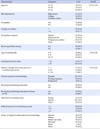Abstract
Purpose
This study was conducted to identify effects of breastfeeding knowledge, attitude, and barriers on breastfeeding practice on twin mothers and to provide basic data for successful breastfeeding for twins.
Methods
Participants were 151 mothers with two to twelve months-old twins. Data were collected from online support groups by an online survey.
Results
Mean score for breastfeeding knowledge was 18.34±4.63, for breastfeeding attitude was 3.61±0.51, and for barriers to breastfeeding was 13.35±1.08. The breastfeeding practice rate was 27.8% when twins were two months old. The breastfeeding knowledge was significantly different depending on mother's occupation, number of children, utilization of postpartum caretaker, and age of the children. There were significant differences in the breastfeeding attitude depending on gestational week of twins, planned length of the breastfeeding, and decision period for the breastfeeding. The practice of the breastfeeding was significantly different depending on the number of children. Factors influencing the breastfeeding practice were the breastfeeding attitude (p<.05), age of mother (p<.01), and the number of children (p<.01).
Figures and Tables
Table 1
Characteristics of Participants (N=151)

Table 2
Levels of Breastfeeding Knowledge, Breastfeeding Attitude, and Barriers to Breastfeeding (N=151)

Table 3
Breastfeeding Knowledge, Breastfeeding Attitudes, and Barriers to Breastfeeding according to Characteristics of Participants (N=151)

Summary Statement
▪ What is already known about this topic?
In Korea, birth rate of twins is continuously increasing, and mothers of twins are having hard time both in initiating and continue breastfeeding their children.
▪ What this paper adds?
Among twin mothers of two-month old babies in this study, only 27.8% were breastfeeding. Factors influencing breastfeeding practice of twin mothers were the breastfeeding attitude, age of mother, and number of children.
▪ Implications for practice, education and/or policy
An educational program starting from prenatal care ineed to be developed and implemented to have optimal result of breastfeeding practice. Also an expert-led support system and educational program that is designed for twin mothers is needed.
References
1. Statistics Korea. Birth Statistics 2015 [Internet]. Daejeon: Statistics Korea;2016. cited 2017 January 5. Available from: http://kostat.go.kr/portal/korea/kor_nw/2/2/1/index.board?bmode=read&aSeq=355736.
2. Centers for Disease Control and Prevention. National vital statistics reports [Internet]. Maryland: National Center for Health Statistics;2012. cited 2016 may 31. Available from: http://www.cdc.gov/nchs/govdelivery.htm.
3. Martin JA, Hamilton BE, Osterman MJK. Three decades of twin births in the United States, 1980-2009 [Internet]. Maryland: National Center for Health Statistics;2015. cited 2016 May 31. Available from: http://www.cdc.gov/nchs/products/databriefs/db80.htm.
4. Park SH, Lim DO. Contribution of maternal age distribution to incidence of multiple birth rates, 1997-99 and 2011-13. J Reprod Med Popul. 2015; 28:96–102.
5. US Preventive Services Task Force. Primary care interventions to support breastfeeding: US preventive services task force recommendation statement. JAMA. 2016; 316(16):1688–1693.
6. Ra JS, Chae SM. Breastfeeding knowledge, attitude, and nursing practice of nurses in neonatal intensive care units. Child Health Nurs Res. 2013; 19(2):76–84.

7. Seo JW. Benefit of breastfeeding. J Korean Soc Matern Child Health. 2004; 3:70–78. Conference Proceeding Book.
8. Ooki S. Breast-feeding rates and related maternal and infants' obstetric factors in Japanese twins. Environ Health Prev Med. 2008; 13(4):187–197.

9. Kim BY. Comparison of factors influencing breastfeeding practice and continuation between twins and singletons [dissertation]. Seoul: Seoul National University;2014. 157.
10. Kim HR. Breastfeeding trends, affecting factors and policy options for breastfeeding promotion in Korea. Health Welf Policy Forum. 2013; 201:49–60.
11. Choi YH, Kim HS, Park HK, Lee YH. Analysis of factors related to breastfeeding practice of breastfeeding. Korean Nurse. 1996; 35(5):98–109.
12. Lee EJ. The effect of prenatal breastfeeding education on breastfeeding practice and retention of knowledge [master's thesis]. Daegu: Keimyung University;1997. 60.
13. Kim SH. Factors explaining mothers' breastfeeding satisfaction. Korean J Women Health Nurs. 2009; 15(4):270–279.

14. Sohn IA. A Study on the factors affecting knowledge about attitudes towards and practice of breast-feeding [master's thesis]. Seoul: Hanyang University;2007. 65.
15. Jeong GH. Effect of the nursing intervention program on promoting the breast - feeding practice in primipara [dissertation]. Seoul: Ewha Womans University;1997. 133.
16. Kim MS, Kim JU, Ahn YM, Bae SM, Kim MJ. The research on the breast feeding and its related factors of premature infant. Child Health Nurs Res. 2003; 9(3):272–284.
17. Korea Centers for Disease Control and Prevention. Korea health statistics 2011: Korea National Health and Nutrition Examination Survey (KNHANES V-2). Seoul: Korea Centers for Disease Control and Prevention;2012. Research Report.
18. Helsing E. Infant feeding and infectious illness. Copenhagen, DK: World Health Organization Regional Office for Europe;1985. Report of the World Health Organization.
19. Lee SS. The 2015 national survey on fertility, family health and welfare. Sejong: Korea Institute for Health and Social Affairs;2015. p. 520. Research Report.
20. Lee SO, Chung ES, Ahn SH, Moon GN, Park NH. A study of predictors of breastfeeding. Child Health Nurs Res. 2003; 9(4):368–375.
21. Lee SO. A study about breastfeeding knowledge, attitude and problem of breastfeeding in early postpartum period and breastfeeding practice. Korean J Women Health Nurs. 2003; 9(2):179–188.

22. Kim M, Kim SH, Lee JH. Types of breastfeeding and its predictors of mothers in twenty-four months after birth. Korean J Women Health Nurs. 2011; 17(1):21–30.

23. Kim KN, Hyun T, Kang NM. A survey on the feeding practices of women for the development of a breastfeeding education program: Breastfeeding knowledge and breastfeeding rates. Korean J Community Nutr. 2002; 7(3):345–353.
24. Yeo JH. Influencing factors in breast feeding duration. Korean J Women Health Nurs. 2005; 11(2):142–147.





 PDF
PDF ePub
ePub Citation
Citation Print
Print




 XML Download
XML Download